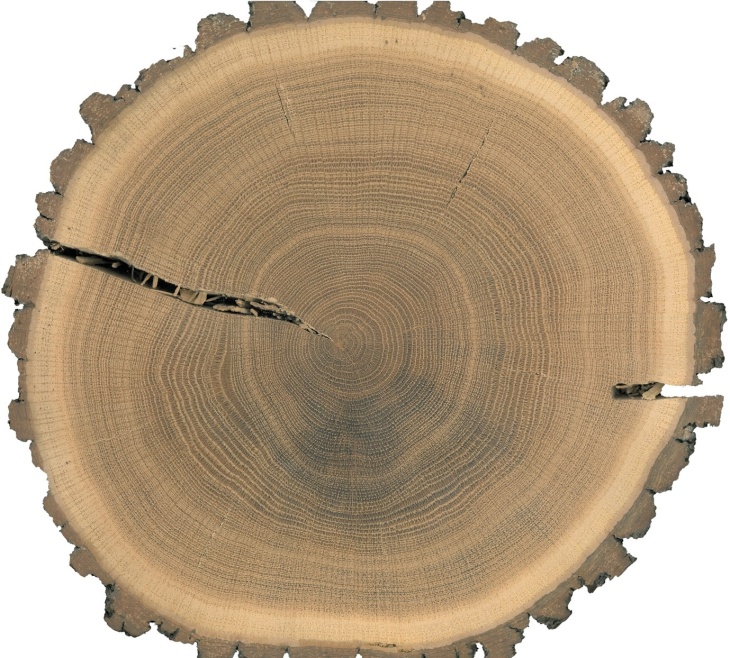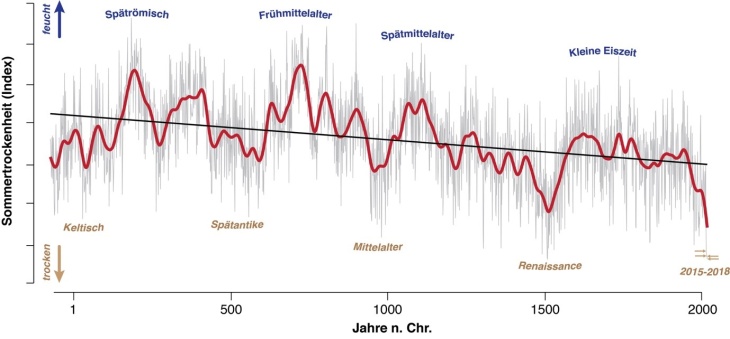Drought summer: drier than ever
Please note: Since the 31st of March 2021 the Helmholtz-Zentrum Geesthacht – Center for Materials and Coastal Research has a new name: Helmholtz-Zentrum Hereon. More information www.hereon.de/name
The drought of the past summers was worse in Europe than ever before, compared to the past 2100 years. This is the conclusion of a new study conducted by an international research team with the participation of Helmholtz-Zentrum Geesthacht - Center for Materials and Coastal Research (HZG). The team examined the chemical fingerprint of European oaks to reconstruct the summer climate over the period of 2110 years. The scientists found a long-term trend toward drought. But since 2015, the situation has worsened – far more severely than in the previous 2000 years. This divergence is likely the result of human-induced climate change. The results of the study were published today in the journal Nature Geoscience.

Cross section of an oak tree trunk. Photo: Ulf Büntgen
Recent summer droughts and heat waves have had devastating environmental and economic consequences in Europe, which could worsen if global warming continues. "We are all aware of this accumulation of exceptionally hot and dry summers in recent years, but we need an accurate reconstruction of the historical situation. Only then will we see how recent extreme events compare to earlier times," says first author Prof. Ulf Büntgen of the University of Cambridge in England and senior researcher at the CzechGlobe - Global Change Research Institute of the Academy of Sciences of the Czech Republic (GCRI).
Stable isotope analysis in tree rings

The droughts increase over the observation period. The more the red line drops, the drier the summer. Graphic: Ulf Büntgen et al.
Most studies that reconstruct past climate are limited to temperature. Stable isotopes in tree rings, however, provide annually resolved and calendar-dated information on hydroclimatic changes. Büntgen and his colleagues from the Czech Republic, Germany and Switzerland analyzed more than 27.000 measurements of oxygen and carbon isotope ratios from 147 European oaks - covering a period of 2110 years. The tree samples came from historic wells, buildings and pile dwellings, as well as from shore sediments and living trees.
Data archive covers more than 2000 years since the Roman Empire
The scientists extracted and analyzed the carbon and oxygen isotopes for each ring of each tree. This allowed them to create the largest and most detailed collection of data on hydroclimatic conditions in Central Europe from the Roman Empire to the present day.
Stable tree ring isotopes differ from the more traditional dendrochronological parameters - which are tree ring width and wood density - because they reflect environmental influences on trees instead of net stem growth. While carbon values depend on photosynthesis, oxygen values are influenced by water supply. Together, the two values show a close interaction with climatic conditions during the growing season.
Recent forest dieback in Central Europe confirms results
During the 2110-year period, there were very wet summers, such as in 200, 720, and 1100 AD, but also very dry summers, such as in 40, 590, 950, and 1510 AD. Despite these years, the results show that Europe has gradually become drier over the last two millennia. The tree samples from 2015 to 2018, however, make it clear that the dryness in recent summers exceeds all other variations in the past 2000 years. Centuries of slow, significant decline were followed by a steep drop. The forest dieback in Central Europe underscores this.
Model-based projections are also used to assess the influence of humans in the future - however, the comparison of the long-term trends of soil moisture from the past investigated in the study shows large differences within different Earth system models and underlines the need in further development and improvement of according model components. "In general, the simulation and estimation of hydrological changes are very difficult because of the complexity and uncertainties of the processes involved," says Sebastian Wagner of the HZG Institute for Coastal Systems - Analysis and Modeling
Overall, the research team believes that the recent spate of unusually dry summers is very likely a result of man-made climate warming and associated changes in the position of the jet stream. This could have devastating consequences for agriculture, ecosystems and society as a whole.
Original Publication
- Büntgen, U., Urban, O., Krusic, P.J. et al. Recent European drought extremes beyond Common Era background variability. Nat. Geosci. (2021). https://doi.org/10.1038/s41561-021-00698-0
Further Information
Contact
Institute of Coastal Systems - Analysis and Modeling
Helmholtz-Zentrum Geesthacht
Communication and Media
Helmholtz-Zentrum Geesthacht
